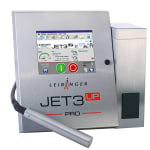
The demands placed on the packaging sector have increased sharply - with increased productivity, Industry 4.0 and individualization in the foreground. Those who need to package products, whether food or consumer goods, will agree: if packaging has to be coded or marked, e.g. with a best-before date or batch number, you need user-friendly, sustainable and perfectly matched solutions. At the FachPack, Leibinger is presenting its low-maintenance, user-friendly inkjet printers which are manufactured exclusively in Germany and feature all commonly used interfaces even in the Basic Line. A widely praised highlight among Leibinger customers is the printers’ fully automatic nozzle seal which prevents the ink from drying up during production breaks – providing manufacturers with decisive productivity advantages.
Leibinger’s “Sealtronic” nozzle sealing technology hermetically seals the entire ink circuit in the printer during production breaks. Air therefore has no chance of penetrating the circuit and drying out the ink. Thanks to this technology, the printer can be restarted within a few seconds at any time and at the push of a button. “Our customers are impressed with this unique function and the feedback we receive is consistently positive,” reports Leibinger Sales Director Coding & Marking Alexander Deuchert from the field. “With printers from other manufacturers, customers often had the problem that they had to clean the printer for up to an hour before restarting production, e.g. after converting a line to a new product, before the first marking could be printed on the product. Since they started using Leibinger printers, this annoying step has been entirely eliminated. At the trade fair, we will be illustrating this decisive added value to interested parties very effectively with a demo print head. The “aha” effect is always amazing.”
Four product lines deliver the ideal solution for every application
Visitors to the Leibinger trade fair stand at the FachPack (Hall 4, Stand 303) like to bring along their own product samples to have them marked directly on site. “Moreover, we will often discuss how we can take on the customer’s or potential customer’s coding and marking challenges and make initial recommendations. Integrated solutions are required for efficient production in line with Industry 4.0 standards,” reports Deuchert. With its four product lines, Paul Leibinger GmbH & Co. KG is ideally positioned to deliver the right CIJ printer to meet every customer requirement. With the JET One, the Entry Line includes a very attractively priced entry-level system for product marking. Leibinger never compromises when it comes to quality, even with its entry-level models. Of course, the Entry Line is equipped with the Leibinger’s patented hydraulic system and therefore offers the typical productivity advantages Leibinger printers are known for.
If you need more interfaces for smart production, the Leibinger Basic Line or the models from the Universal Line are the perfect choice. The latter, with the JET3up PRO, also has a dust- and splash-proof model that complies with the IP65 protection class. Thanks to the printer’s high-quality stainless steel housing, this model is often used in production environments with high hygiene regulations. Leibinger also has a High Speed Line in its range for particularly fast production lines: it prints a legible code at line speeds of up to 1000 m/min.

Suitable for wet production environments: The Leibinger JET3up PRO with protection class IP65.
Unbeatable flexibility coupled with maximum reliability
Production managers often raise the question as to the most suitable technology for the specific marking tasks in their company. The focus should be on factors such as future sustainability, cost efficiency and operational reliability. Continuous Inkjet (CIJ) technology is characterized by the greatest possible flexibility in use. It can be used for virtually all tasks along the packaging process chain and copes well with most substrate materials. High printing speeds and marking during ongoing production help to ensure that highly automated production processes are not slowed down by the coding or marking process.
When switching a production, the printers can be changed over to a new product with just a few simple steps. This is especially important when the packaging market is confronted with changing requirements, e.g. brought about by ecological trends. For Christina Leibinger, Managing Director at Leibinger, it is clear: “The trend is towards environmentally friendly packaging. Thinner-walled and alternative plastics are used, in some cases plastic is entirely replaced by other materials made from renewable raw materials.” Production systems need to be able to handle this change – which of course also means that flexibility in labeling technology is a fundamental criterion in investment decisions. “Our customers count on a very flexible and well-functioning system that can also be used to meet changing requirements and therefore offers the greatest possible sustainability,” reports Christina Leibinger.
When it comes to materials, the flexibility of CIJ systems is once again evident. High-contrast codes can be easily applied to cardboard, plastic, shrink film, foam, glass or metal. Since the technology works without contact, it doesn’t matter whether the surfaces are flat, concave, convex, relief-molded or porous. Leibinger inkjet printers always impress users with extremely low operating costs over their entire life cycle.


